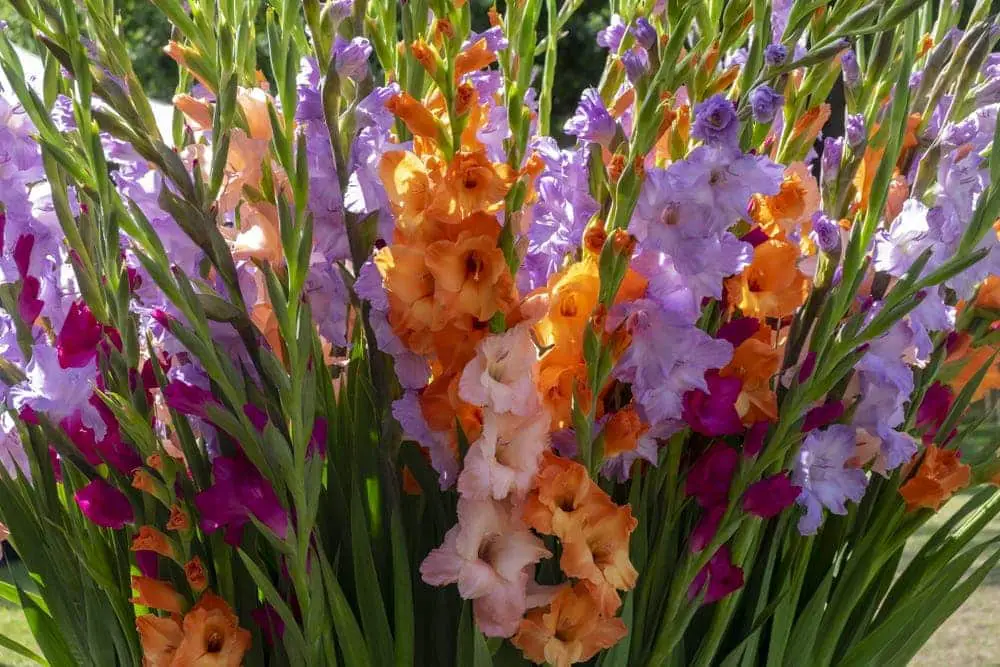The gladiolas plant is a plant that grows from an underground root system. This is called a corn.
It adds beauty to any garden or flower arrangement. They are native to Africa so they prefer warm climates and warm soil to grow.
Gladiolus Plant Care and Growing Guide
1. About Gladiolus
This flower is known for its large, colorful blooms and tall flower spikes. It is a perennial, which means it comes back every year. They grow in the warm summer weather and you can keep them blooming by planning corns every few weeks.
They are easy to grow. They are also referred to as Sword-Lilies. In addition to being used as a cut flower, they can also be used as a border or grown in containers. There are over 250 different species of these beautiful plants.
2. Light Requirement
These need full sun. They can bloom in the shade but you will have flower stalks that are floppy and smaller flowers. They require six to eight hours of full sun each day, especially if you want to grow large blooms.
3. Water
During the growing season, you need to provide your gladiolas with consistent moisture. Do not allow the soil to dry out. You can reduce your watering after flowering. On average, they need at least an inch of water a week. To help keep the moisture in the ground for the plant you can also place at the base of the plant, two to three inches of mulch.
4. Climate
Zones 8-11 but in zones 6-7 they will thrive if you protect the bulbs with thick mulch throughout the winter.
5. Soil
In order to grow properly, they need to be planted in fertile soil that has excellent drainage. After the new growth appears, you will need to top-dress them with rich compost. This is usually early summer.
If you have soil that it is filled with clay, it will be too wet to grow gladiolas so you will need to put them in raised beds. When the buds are first starting to form you should fertilize your plants using a fertilizer that is high in phosphorus to help the buds to develop.

6. Potting
When planting gladiolas most plant them in their flower garden but if you want to plant them inside, you need to choose the smaller variety so they do not outgrow their container or space where you want to put them.
The pot that you choose has to have a lot of draining holes and is at least a foot deep. It also needs to have a 12-inch diameter. Once you have planted the corns, you will have to provide it with a lot of suns and keep the soil moist.
7. Speed of Growth
From the day you plant the corns to seeing the flowers is about 10-12 weeks. It all depends on the variety of gladiolas and the weather.
8. Height and Spread
These beautiful flowers can reach between two and five feet in height with a bloom that are less than three inches to five inches across. For the taller variety, you may need to stake them.
More like this: Oxalis Plant Care & Growing Guide
9. Flowers
The flowers come in blue, green, purple, white, pink, red, yellow, and orange with blue/green foliage. They only grow on one side of the stem with the largest flower at the bottom of the stem. The flowers at the bottom of the stem will generally open first. This is the flower that hummingbirds like.
10. Propagation
They do not naturally spread in the garden but the bulbs can multiply and create baby bulbs. They can be propagated by digging up the bulbs at the end of the growing season and dividing the new bulbs.
Another method is to germinate seeds. With this method, it will require a few years of planting for the plant to bloom. To germinate seeds, leave the dead blooms on the plant for six weeks. After this time, you will find a hard seed casing. This will require two to three years of care to get it to bloom. The fastest way to have new plants is by dividing the bulbs and plant the corns next planting season.
Similar post: Aloe Vera: Plant Care
11. Trimming
When you trim or prune, gladiolas, it is the blooms that must be pruned. They are beautiful but in time they start to shrivel and fade so you will need to deadhead them so the plant can continue to grow and bloom. Once the blooms are gone on a specific stem, you will be able to cut the stalk. Cut it about two to three inches above the soil. When you grow them inside, you will generally not need to prune them.
Learn more: Kangaroo Paw Fern Care & Growing Guide
Is Gladiolas Poisonous?
Yes, the bulbs are toxic to cats, dogs, and horses if ingested and the same for children but not if they touch them.
Common Gladiolus Plant Problems
- Under-watering: This can result in smaller corns for planting, smaller flowers, and shorter spikes
- Thrips: These are a small insect that feeds on the leaves and blooms of the plant. One way to help prevent this problem is to dip the corns in boiling water before you store them for the winter. If they are in the ground, spray the plant with Neem Oil.
keep reading: Monkey Tail Cactus: Plant Care & Growing Guide
Conclusion
Gladiolas is a beautiful flower and comes in a variety of colors that can dress up a flower garden or in a vase in your home. When you plant your corns, for the best visual impact, plant them in groups of a minimum of seven corns.
On average, they bloom for two weeks or more but if you want to extend the colorful flowers you can plant the corns every two weeks until early summer. They are considered perennials in Zone eight to ten but annuals in zones seven and below, which means you have to dig the corns up and store them if they are annuals.
The bulbs are toxic to pets and children so make sure they are not left lying around for pets or children to chew on.
Also read:
- Mexican Heather: Plant Care & Growing Guide
- Dischidia: Plant Care & Growing Guide
- Morning Glories: Growing Guide
Victoria is the owner and main author of hobby plants. She loves spending her free time in her garden planting and taking care of her plants. Victoria hopes you enjoy the content here!




![Mother Of Thousands Plant [Complete Plant Care Guide] Mother Of Thousands Plant [Complete Plant Care Guide]](https://www.hobbyplants.com/wp-content/uploads/2022/07/mother-of-thousands-plant-300x158.jpg)
![Majesty Palm Plant Care: [Complete Beginner's Guide] Majesty Palm Plant Care: [Complete Beginner's Guide]](https://www.hobbyplants.com/wp-content/uploads/2022/08/majesty-palm-care-300x158.jpg)
![Exotic Angel Plant Care: [Complete Beginner's Guide] Exotic Angel Plant Care: [Complete Beginner's Guide]](https://www.hobbyplants.com/wp-content/uploads/2022/08/exotic-angel-plant-care-300x158.jpg)
![Snow White Waffle Plant: [Complete Care Guide] Snow White Waffle Plant: [Complete Care Guide]](https://www.hobbyplants.com/wp-content/uploads/2022/08/snow-white-waffle-plant-300x158.jpg)
![Waffle Plant Care: [Complete Beginner's Guide] Waffle Plant Care: [Complete Beginner's Guide]](https://www.hobbyplants.com/wp-content/uploads/2022/08/waffle-plant-300x158.jpg)
![Bird Of Paradise Plant Care: [Complete Beginner's Guide] Bird Of Paradise Plant Care: [Complete Beginner's Guide]](https://www.hobbyplants.com/wp-content/uploads/2022/08/bird-of-paradise-plant-300x158.jpg)
![Purple Passion Plant Care: [Complete Beginner's Guide] Purple Passion Plant Care: [Complete Beginner's Guide]](https://www.hobbyplants.com/wp-content/uploads/2022/08/purple-passion-plant-care-300x158.jpg)
![China Doll Plant Care: [Complete Beginner's Guide] China Doll Plant Care: [Complete Beginner's Guide]](https://www.hobbyplants.com/wp-content/uploads/2022/09/china-doll-plant-care-300x158.jpg)